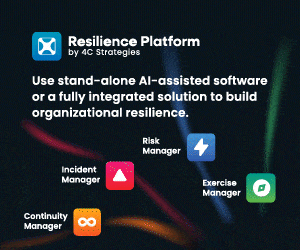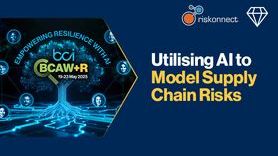Embedding Business Continuity for a More Resilient Future

The world can be an unpredictable place, the business world even more so. With sudden interruptions like weather, the recent pandemic, natural disasters, and potential cyberattacks, businesses need to prepare.
Educating your organisation about business continuity management (BCM) is essential – not just this month but all year long. Many enterprises have already formed thorough business continuity plans, but bringing the entire organisation on board will help you fully embed your plan and create organisational resilience.
How to Maintain Your Business Continuity Plan
A business continuity plan is only useful if it’s up to date. Your team relies on the information in your plan to act when an incident occurs. It also is an excellent tool for embedding BCM into the enterprise.
Automation
Using BCM software to maintain your program breaks down silos, engages personnel in BCM, and shows organisational commitment to BCM. Having the business process owners and subject matter experts update their parts of the plan helps to engage them and others with your organisation’s BCP. In addition to making BCM more visible across the enterprise, automation makes your plans more reliable as they will be easier for everyone to maintain. Automation allows automatic uploads for data like personnel and technology and notifications of program tasks, such as approvals and reminders, to improve resiliency.
Make sure that you’re also maintaining your organisation’s risk assessments, business impact analyses, and business continuity plans, adjusting them based on changes in personnel, location, possible threats, and more.
Exercising
Building awareness across the organisation and exercising regularly will make your plans more actionable and embedded within your team. Ensure everyone understands their roles during a disaster and is ready to act. The better people know the plan, the quicker and more agile they will be.
Training and exercising your plans also help validate the plans and uncover caps, fix problems, and find vulnerabilities, making your plans more viable and achieving greater buy-in from the entire organisation.
There are different types and levels of exercises, and you don’t have to start from scratch; you can use tabletop exercise templates to test and train your organisation. Types of exercises include:
- Discussion-based exercises, such as walkthrough and tabletop exercises. These provide an overall collaborative orientation to the plan.
- Operational-based exercises, such as functional and full-scale exercises. Operational exercises may be done at alternate sites to validate the recovery process or simulate the business function(s) under this condition.
Exercises aren’t meant to be pass or fail; instead, they promote collaboration, discussion, and brainstorming.
Awareness
Once you have the appropriate planning in place, the most important thing to do is to keep your team aware of the possibility of a crisis and how you're going to handle it.
Make sure key managers attend regular meetings about BCM and your business continuity plan. You may even want to circulate news clips and other media about what other relevant companies have gone through.
You don't need to be "doom and gloom." Just keep your organisation on its toes. It's important that you don't loosen the reins when it comes to this part of business continuity.
It's easy to structure a plan and appoint a team, but if your people aren't aware of how it's going to play out in a real-life scenario, there is no point.
Embedding your plan relies on constant planning and awareness. Here are a few tips you can use to help embed the business continuity process into your team.
- Hold general briefings and presentations to your entire staff on business continuity
- Conduct tests and exercises that realistically simulate real-life events
- Have observers sit in on and evaluate your team's exercises and tests
- Train all new hires on your business continuity plan
- Incentivize members of your company to attend BC conferences and expositions
- Hold regular business continuity consultations involving all departments
- Use internal webpages and other infrastructure to spread the word
- Highlight business continuity in your company newsletter
- Make BCM part of regular meeting agendas
- Plan visits to proposed recovery sites
Promote Operational Resilience
To be resilient, your company needs the ability to deliver critical operations through disruptions. By embedding business continuity throughout your organisation, you’ll be better prepared to maintain operations in the face of incidents. Anticipate, prepare, respond, adapt, and learn.
About Agility
Agility provides simple, flexible business continuity solutions, allowing organisations to manage their entire business continuity program from one central platform. Agility is the industry’s most comprehensive yet simple business continuity platform to help organisations plan, train, test, alert, and recover – all in one. Whether you’re a seasoned continuity professional or creating your company’s business continuity plan for the first time, we’re ready to support you and your team. For more information, visit agilityrecovery.com or call 1-866-364-9696.









































